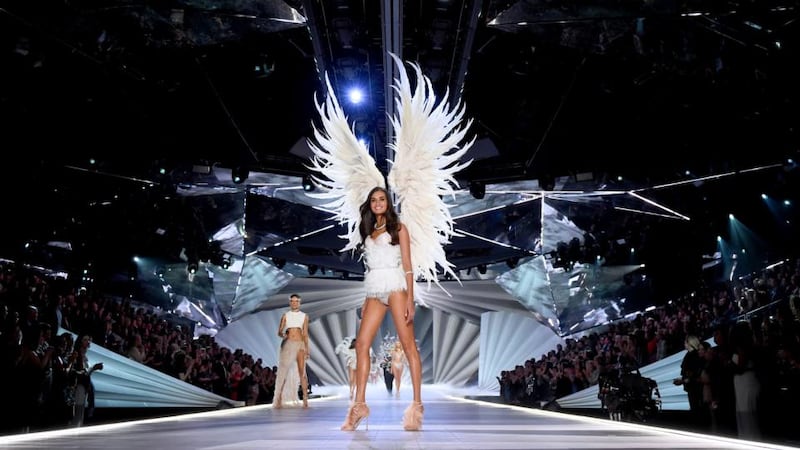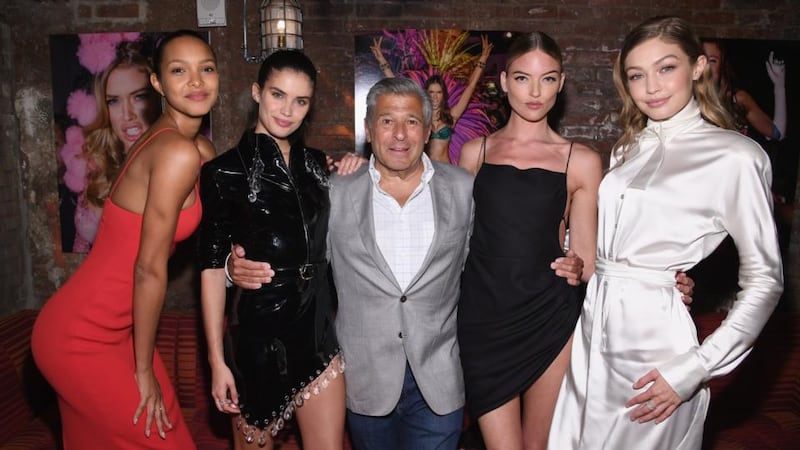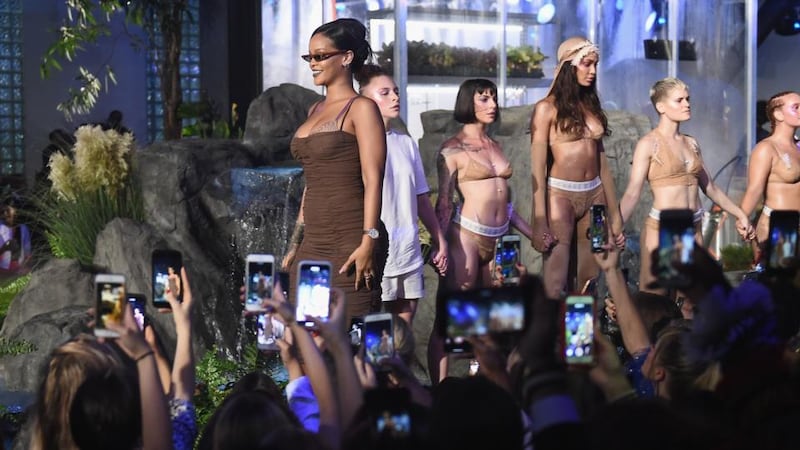A woman stands on stage and cries. In the auditorium another woman's partner gives a standing ovation, his hand on his heart. One mother gushes that she is "so proud" of her daughter. Another goes further: "So much admiration for all your hard work and dedication to being the best version of yourself and making your dreams come true."
We are told that these women are "athletes", that they are in "peak condition", that they are "aggressively fit". But this is not the Olympics or the Paralympics. There are no medals to be won. This is a lingerie show.
Launched in 1995, the Victoria's Secret runway show has been broadcast on US network television every December since 2001, an extraordinary feat for a high-street underwear brand. Almost from the beginning it has been under fire. In 2002 the United States' National Organization of Women protested at the event, calling it a "softcore porn infomercial". One fashion editor told me that the year she covered the show was the "worst job I'd ever done. All the models look the same. The underwear is so skimpy you can literally see everything. One of them bent over in a thong, and I saw it all."
The Victoria's Secret show's strict weight and body-fat requirements are far beyond the reach of most women. Indeed, they are far beyond the reach of most models
The show's uniformly tall and thin models seem an anachronism in a world that increasingly celebrates body diversity. Yet its star has continued to rise. Last year it was watched by more than a billion people worldwide, claimed to be a 45 per cent increase on the year before. And, despite a recent fall in sales and the resignation of its chief executive, Victoria's Secret still has a bigger global market share than any other lingerie brand. Its three highest-profile models – Kendall Jenner, Gigi Hadid and her sister Bella – have more than 163 million Instagram followers between them, and some of the biggest names in entertainment, from Taylor Swift, Harry Styles and Ariana Grande to Sting and Lady Gaga, have played the Victoria's Secret catwalk. When this year's show airs next weekend, on Sunday, December 2nd, if you are a young woman with access to the internet, Victoria's Secret will be impossible to avoid.
That is why it is so pernicious. Earlier this month Ed Razek, the chief marketing officer of Victoria's Secret's parent company, L Brands, was forced to apologise after telling Vogue that he didn't want transgender models in the show because it would spoil the "fantasy". In the same interview he said there was no interest in portraying a wider range of sizes and shapes.
“I’m always asking myself: if we do that, what is the reason we did it?” he said. “Did we include them because it was the right thing to do or because it was the politically correct thing to do? Do they take the place of somebody who worked for a year for the opportunity and cried when they found that they got it?”
"Hard work" is a term you hear a lot around Victoria's Secret models, or "Angels", as those who have signed an exclusive deal with the brand are called. It means exercise: training, toning, boxing, skipping, using the hashtag #trainlikeanangel and working out in invite-only classes with names such as the Skinny Bitch Collective.
It is no wonder that many of the models exercise obsessively. The show’s strict weight and body-fat requirements, endlessly speculated on in the media, would be far beyond the reach of most adult women. Indeed, they are far beyond the reach of most models, which is why the 50 or so who are picked for the VS “family” each year must endure months of dieting and exercise.

The model Robyn Lawley has appeared in Sports Illustrated and on the covers of Vogue Italia and Vogue Australia, as well as modelling Ralph Lauren, H&M and Chantelle lingerie. She went to a Victoria's Secret casting six years ago – but was not hired. "It's a running joke that they see curvier girls every year and never cast them," she says. "This whole starvation-camp situation before you have to walk that catwalk is ridiculous. Some of them are my friends on that stage; I'm not pulling them apart. But they have to put their bodies to such extremes once they cast the show, they couldn't maintain that kind of lifestyle or they'd die."
Yet this lifestyle is pored over by the world's media. Grazia, Vogue, Elle and the Daily Mail, among others, have all published guidance to looking like a Victoria's Secret model. Occasionally, they get journalists to try it themselves, and they end up exhausted and hungry, unable to eat out with friends or concentrate. One diet, suggested by the trainer Stephen Pasterino, is so restrictive that, by the end, even cauliflower and broccoli are out.
Adriana Lima, the brand's longest-serving model, once said she cuts out all solid food nine days before an appearance. Many models do not drink fluids, either
The model Barbara Palvin’s boyfriend bought her a bag of cheeseburgers to eat after this year’s show, as if to prove how little she had eaten beforehand.
Adriana Lima, the brand's longest-serving model, told the Telegraph in 2011 that she cuts out all solid food nine days before an appearance. Many models do not drink fluids, either. "Dehydration is a massive problem," one fashion editor told me. Yet every year this event, this circus of competitive anorexia, is broadcast, streamed, applauded.
Publishing details of these regimes, with no warning from medical professionals about their long-term effects, allows a culture to flourish where women are rewarded for their ability to restrict, to deny themselves, to go without. It legitimises a world view where foods are divided into good and bad, where spinach is clean and cake is dirty, where any moment not spent exercising is a moment wasted, and where being thin is a marker of togetherness and control and success.
Lima is retiring from the brand this year, after 20 years. In June a video on her Instagram account showed her struggling through a workout. "Seeing this video makes me emotional," she wrote. "Sometimes people look at you from the outside and think: her job is so easy (remember I am not complaining), when they don't know what you go through. Here I am, four weeks after giving birth to my beautiful daughter Valentina and after days of physical therapy because I had a fractured knee, putting all my focus to get ready for a fashion show (60lb heavier, lol). I learned something during that time. Once you love something, absolutely nothing in this world will have the power to stop you, not even your mind or body!"
It is hard to imagine how a brand that claims to have the best interests of its models at heart could allow a woman who has been integral to its identity to ignore all physical and psychological warning signs in her struggle to lose enough weight to be worthy of one more show.

Razek denies that the brand has a hand in how the models train. "The girls have just continued to get more physically fit," he told Vogue. "We don't tell them to; they compete with one another and they work hard, they work in pairs, they work in threes." This seems at odds with an interview he gave to Forbes in 2015, in which he recalled a model asking him why she didn't make it into the show after appearing the year before. He replied: "Every night, I see a picture of you on Instagram from a club, night after night, and every night [while] you were doing that, Adriana Lima was jumping rope for three hours."
The message is this: you are not good enough as you are. If you want to be an Angel you must diet and train like one – and if you do not, you are out.
“It’s pitting girls against girls, which I think is a revolting technique,” says Lawley. “Razek is trying to make it out as though he’s got nothing to do with it, which is complete bullshit. It wouldn’t happen like that normally; those girls don’t have to starve themselves like that when they’re not working for that runway.
“They all have body dysmorphia. That’s the thing: all these girls, they all have beautiful bodies; none of them need to do any of it. That’s the irony of the whole thing.”
“We would never dictate any sort of diet regimen for our models,” says a Victoria’s Secret spokesperson. “We promote a healthy lifestyle.”
Earlier this year Bridget Malcolm, who modelled in the 2015 and 2016 shows, apologised for publicising her "damaging eating habits" and exercise regime. It was an enormously brave thing to do. "Body dysmorphia is a terrifying thing," she wrote. "I have had countless conversations with fellow models, all of whom are tiny, where they call themselves fat. It is such a hard thing to understand if you are removed from this... but when it becomes a mental game like this, it grows wings of its own."
In 2016 another former Angel, Erin Heatherton, said she had been pressured to lose weight by the company. Despite exercising twice a day, and following a strict meal plan, she was unable to meet the targets set for her. "I got to a point where one night I got home from a workout and I remember staring at my food and thinking maybe I should just not eat," she said. "I realised I couldn't go out into the world – parading my body and myself in front of all these women who look up to me – and tell them that this is easy and simple and everyone can do this."
And that is where the brand unravels. Cutting out food groups, forgoing seeing friends to exercise, being unable to eat socially, obsessing about diet, size and shape: anyone who has suffered from an eating disorder will be familiar with all of the above. I spent a full year in hospital at the age of 32 trying to overcome an eating disorder that had gripped me since childhood. It is a long battle, fought every day, sometimes every second, but I know that continuing on that path does not open a door to happiness or love or safety; it is one of torture, punishment, toxic voices, broken relationships and denial. To package these behaviours as a “fantasy” shows nothing but contempt for these women.
The casting for the Victoria's Secret shows is a humiliating ritual in which models must essentially beg for the job. Gigi Hadid virtually prostrated herself
Through it all, the models are expected to be grateful for the opportunity. The casting for the Victoria’s Secret shows is a humiliating ritual, one in which models must essentially beg for the job. The video for Gigi Hadid’s casting shows one of the most successful models virtually prostrating herself. The brand then publishes this as a marketing tool.
“I used to think about what this moment would feel like, and it’s indescribable,” her fellow model Maia Cotton says in a quote on the brand’s Instagram.
"This has been my dream since I was a little girl," says Willow Hand. "I've never worked so hard or wanted something in my life so badly."
“It’s almost like they’ve turned the Victoria’s Secret show into the American dream,” says Jerrold Blackwell, who handles new faces and scouting at Next Model Management in Los Angeles. “Once you’ve gotten to this point as a model, this is the pinnacle. You’ve made it. It’s your identity, worth and status.”
The company has not always rewarded the models with the same loyalty. In 2012 the show's creative director, Sophia Neophitou-Apostolou, was asked by the New York Times whether she would cast the "plus-size" model Kate Upton, who had already appeared in the brand's catalogues. Upton would "never" get cast, Neophitou-Apostolou said. "She's like a footballer's wife, with the too-blond hair and that kind of face that anyone with enough money can go out and buy."
Michelle Cordeiro Grant is a former senior merchant director at Victoria’s Secret. She left in 2012 because she “started to take issue with the fact that I was working on these marketing campaigns, and I wasn’t feeling good about myself. It hit home when I got married and I had children. I said to my husband: ‘This isn’t a message I want to share with my daughter.’ ” In 2016, she started her own lingerie company, Lively, which uses a wide range of models and stories from real women in its marketing campaigns. It has been a huge success.
“Victoria’s Secret has never changed,” says Cordeiro Grant, “but the world around them has. I was walking through the subway station the other day in Manhattan, and I looked at the ad for the Angels’ ‘fantasy’ runway show and I said to myself: ‘That could be today, or 30 years ago.’ ”

Over the summer I was coming out of Oxford Street Tube station in London when something stopped me in my tracks. Women's bodies. All different colours and ethnicities, all shapes. They had thighs and breasts and stomachs, and flesh. Soft, everyday flesh. The posters were enormous, twice the size of me. It was a celebration of women's bodies like I had never seen in mainstream advertising. The woman behind this was Rihanna, the pop star-cum-lingerie designer, whose Savage x Fenty range has radicalised the industry. Her show at New York Fashion Week was a parade of diversity. It could not have been further removed from the sheen and pomp of Victoria's Secret's. The message was one of individuality and emancipation: "Women should be wearing lingerie for their damn selves," she has said.
To be fair to Victoria's Secret, its claim that the shows have been "culturally diverse for a long time" is accurate. The show has featured models of colour since its inception, and Blackwell says the company has been asking for more of them in recent years – "particularly Asian girls, girls you don't often see on the runway". One model he has worked with, Aiden Curtiss, has walked for Victoria's Secret and "does it in a really healthy and happy way", he says. "She loves being a black woman who is able to represent on that runway." However, it has also been accused of cultural appropriation, in particular for using Native American headdresses on the runway.
All the same, the brand is falling out of sync with the young women whose spending power it relies on. Its beloved plunge bras have been mocked for not even fitting the models who wear them. Rivals such as Savage x Fenty and American Eagles' Aerie brand (which prides itself on avoiding airbrushing and using diverse models) are gaining more market share as women and girls look for comfort, positive reinforcement and bras that are actually comfortable. Third Love even took out a full-page advert in the New York Times this week to denounce Razek's comments, describing itself as the "antithesis" to Victoria's Secret.
Some models are starting to distance themselves from the show. "Feeling so much better about not doing BS… sorry, I mean VS, now that Rihanna isn't doing it also," Jourdan Dunn tweeted (and then deleted) after the pop star pulled out of performing in 2016.
Most fashion insiders will tell you that the Victoria’s Secret show is outdated, a relic, a product of a bygone era. But they will add that it still matters. “Doing that show could fast-track your whole career,” one model told me. Blackwell describes it as “absolutely life-changing” in terms of the opportunities it opens and the financial rewards.
Personally, I would like to see the show go the same way as plastic straws and carrier bags: shunned and boycotted. I would like to see those pop stars who preach body positivity refusing to play until the brand catches up with the times. Then I would like to see the lingerie industry reborn, using its power and influence to encourage diversity and a world where food is nourishment and exercise is for wellbeing, not punishment. A place where women can give themselves a break for once and enjoy being good enough, exactly as they are. – Guardian












